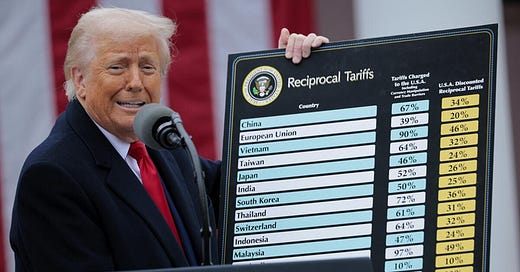Quick Take: Trump's Tariff Follies
But the dismal science is coming for the president and his supporters
Among the predatory foreign countries that have grown rich by pillaging the American economy is…Cambodia. This must be so, for President Trump has included Cambodia in his punitive tariff war, which pits American against the world.
According to the Office of the United States Trade Representative, US-Cambodian trade totaled around $13 billion in 2024, and the US trade deficit with that country was $12.3 billion. Textiles, clothing, travel goods (luggage), and footwear account for about seventy percent of Cambodian exports to the US. The major US exports to Cambodia are vehicles, vehicle accessories, and automotive repair parts, to the total of around $115 million.
In 2024, the US GDP was $29.7 trillion; the Cambodian GDP was $38 billion.
Trump has justified the imposition on punitive tariffs on Cambodia with the claim that it imposes a ninety-seven percent tariff of US imports—a characteristically wild exaggeration. The true figure is around twenty-five percent and the minuscule trade deficit that the US runs with Cambodia is a mere rounding error. But never mind! Just to show what a tough guy he is, the President is intent on wrecking the economy of a small, poor country that poses no economic or security threat to America.
As the Cambodian example suggests, Trump’s tariff war is entirely fanciful, founded on bogus statistics and pure magical thinking. It rests ultimately on two assumptions: (1) that it hurts American workers if American consumers have access to imported goods at low prices and (2) that the American worker and the American consumer are two different people.
In reality, low-priced goods benefit both the American worker and the American consumer—because they’re the same person. And on the flip side, punitive tariffs on imported good hurts the American worker/consumer. Trump and his supporters would have you believe otherwise, but his tariffs are really an indirect tax on Americans, this because any increase in the cost of doing business is ultimately passed along to the consumer. And this indirect tax falls most heavily on the working class, whom the Trump tariffs are supposed to be protecting from predatory foreign competition.
There’s no way around these economic realities, as a simple thought experiment will illustrate.
Assume that a fifty percent tariff is imposed on all imports of foreign wine. Suddenly, American devotees of French reds and German whites find themselves paying significantly higher prices for their favorites. But that’s fine, say Trump & Co. Those consumers can purchase American wines instead. Demand for American wine therefore increases. But due to the constraints imposed by viniculture, the supply of quality American wine cannot be instantly increased. Indeed, it will take years to ramp up production. So the price of American wine will shoot up, or its quality will decline significantly, or both.
And nobody wins. There’s a reason why economics is called the dismal science: The reality checks it administers tend to be painful.
All the Trump Administration happy talk concerning a tariff-driven American manufacturing renaissance is, in a word, claptrap. In the first place, it takes more than a snap of the fingers to create a new steel mill or automobile factory—years, in fact. And by depressing incentives for capital investment, the Trump tariff regime makes it unlikely that a manufacturing boom will occur. Why, for example, would domestic automobile manufacturing boom in an economy when the price of a key raw material, steel, has been driven up by tariffs?
Some of the President’s apologists take the line that his tariff war is a ploy: Trump the Master Negotiator’s opening gambit in a multi-dimensional economic chess game to conjure up a new age of American prosperity. If that were so, the Trump Administration wouldn’t be picking on a small country like Cambodia, whose trade relationship with the US is of no real economic consequence. A case can be made for the imposition of punitive tariffs on a country like China, which actually does screw over America, for instance the theft of intellectual property. But Cambodia? Please!
The American electorate’s discontent with the economic mismanagement of the Biden Administration is one big reason why Donald Trump is sitting in the Oval Office today. The inflationary spiral touched off by Biden’s profligate spending hit Americans hard—especially lower middle-class and working-class Americans, for whom the price of gas and groceries is always a major concern.
But now, by a different route, Trump is preparing the ground for another inflationary spike, this one founded on the economically illiterate idea that trade protectionism is the magic elixir of prosperity. But here’s the truth: None of the benefits that the President is promising will be forthcoming. On the contrary, if his tariff regime is fully implemented, the cost of living will go up while the economy stalls and stagnates.
There’s a word for that malady: stagflation. As I well remember, America suffered through it in the Seventies—and in his ignorance and hubris, the Prince of the Golden Escalator is reviving it to blight the country anew.




thanks for sharing your well spoken economic literacy, somewhat rare these days..
Tariffs on specific products and countries makes sense especially one that steal intellectual property. The best way for America to outperform the world is through a three pronged approach that doesn’t involve tariffs. Lower energy prices, reduced regulations and licensing times and innovation. The last is built into our DNA and will take care of itself. The first two are government policies. Take care of the government side and the people will do the rest.